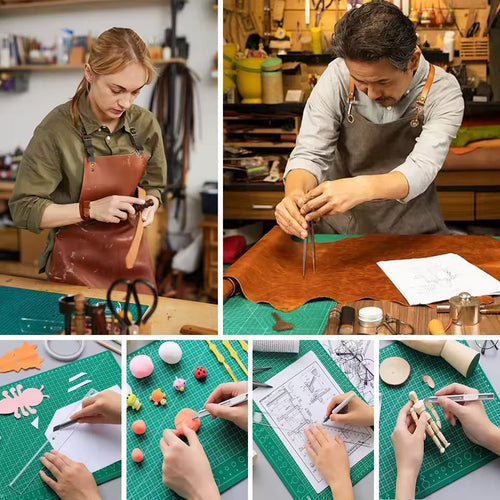This article explores why a rotary cutter is a game-changer for quilting. It compares rotary cutters with scissors, explains how they improve accuracy, speed, and comfort, and helps beginners and experienced quilters choose the right tools. Whether you are cutting for patchwork or piecing layers, this guide from HandMade Keeps breaks it all down clearly.
Why a Rotary Cutter is a Game-Changer for Quilting
Rotary cutters make quilting faster and more precise than using scissors. While scissors work for basic fabric cutting, they can cause uneven shapes and hand fatigue over time. A rotary cutter, with its sharp circular blade, rolls smoothly over fabric to produce clean lines in a fraction of the time. Quilters at HandMade Keeps have found this switch improves the quality of their work and makes the whole process more enjoyable.
What is a Rotary Cutter for Quilting?
A rotary cutter is a handheld tool with a round, sharp blade that rolls to slice through fabric. Quilters use it to cut multiple layers with accuracy. Unlike scissors, rotary cutters keep the fabric flat, reducing shifting or uneven cuts. Blade sizes vary:
-
28mm – best for curves and small pieces
-
45mm – great all-round size for most projects
-
60mm – ideal for thick layers or larger pieces
At HandMade Keeps, we recommend starting with the 45mm cutter for general quilting needs. You can pair it with our Quilt Cutting Template for better accuracy and results.
Benefits of Using a Rotary Cutter for Quilting
Faster Cutting Speed
Rotary cutters glide through several layers at once. This helps quilters cut faster, especially for large batch projects like patchwork quilts or repeated shapes. Using a tool like our Multi Craft Fabric Template can speed things up even more.
Precise & Clean Cuts
With the help of quilting rulers, rotary cutters ensure smooth edges and reduce errors. No more jagged lines or fraying fabric edges.
Consistency in Shapes
Every quilt block looks the same, reducing the need for extra trimming. This makes piecing easier and keeps patterns aligned.
Reduced Hand Fatigue
Ergonomic rotary cutters require less pressure than scissors. Your hands feel less strained after long hours of cutting fabric.
Rotary Cutter vs Scissors for Quilting
| Feature | Rotary Cutter | Scissors |
|---|---|---|
| Speed | Cuts multiple layers | One layer at a time |
| Accuracy | Clean, straight edges | Harder to cut perfect shapes |
| Comfort | Less hand strain | Causes hand fatigue |
| Versatility | Works with rulers and templates | Limited for precision |
| Best Use Case | Patchwork, multiple fabrics | Single-layer cutting, curves |
How to Use a Rotary Cutter Properly
Safety Tips
Use a self-healing cutting mat to protect your surface. Always retract the blade when not in use. Keep it away from children.
Techniques for Straight Lines
Pair the cutter with an acrylic quilting ruler. Hold the cutter upright at 90 degrees for clean, straight lines.
Cutting Curves and Appliqué Shapes
Use a smaller 28mm blade for curves. A rotating mat helps reposition fabric without lifting it, improving control.
Best Rotary Cutters for Quilting in 2025
Top brands include OLFA, Fiskars, and Martelli. When choosing a rotary cutter, look for:
-
Comfortable handle
-
Sharp and replaceable blade
-
Reliable locking mechanism
-
Fair price point
At HandMade Keeps, we carry patchwork rotary cutters that balance performance and price, perfect for hobbyists and pros. For extra support, consider our Ultimate Bundle of Quilting Guides to master the tools step-by-step.
Tools You Need with a Rotary Cutter
To get the best results, you need more than just the cutter:
-
Self-healing cutting mat – prevents blade damage and protects surfaces
-
Acrylic quilting rulers – help guide straight cuts
-
Blade sharpener or replacements – keep your cuts clean and accurate
Check out our bundle that includes a cutter, mat, and guide – all in one Quilt Cutting Template with Free Gift Offer.
Common Mistakes When Using a Rotary Cutter
-
Using a dull blade leads to skipped or uneven cuts
-
Skipping the cutting mat can damage your table and the blade
-
Pressing too hard or cutting at the wrong angle causes ragged edges
Check your tools before every project to avoid these issues.
Rotary Cutters for Beginners: What You Need to Know
Start with a 45mm rotary cutter. It suits most projects. Always use it with a mat and ruler. Practice on scrap fabric until you get comfortable. Safety is important—keep the blade closed when not in use.
Rotary Cutter Maintenance & Blade Care
Change the blade if it skips or drags. Clean lint from the blade area often. Always store the cutter with the safety cover on. This keeps it sharp and safe. You can also add our Shipping Protection at checkout to secure your quilting tools in transit.
Can a Rotary Cutter Cut Through Batting and Multiple Fabrics?
Yes. A sharp 60mm blade can cut up to 6 layers of fabric and even batting. For best results, press the fabric flat, use a fresh blade, and cut on a firm mat.
Environmental Impact: Are Rotary Cutters Sustainable?
Rotary cutters reduce waste by using replaceable blades. Many brands now use recyclable packaging. Look for eco-conscious options like OLFA’s refillable blades when shopping at HandMade Keeps.
Testimonials from Quilters Who Switched to Rotary Cutters
"I used scissors for years—never again! My blocks are finally straight." – Karen, Texas
"I finished cutting a queen-size quilt in half the time." – Dee, Missouri
"My hands used to hurt after every session. The rotary cutter changed that." – Susan, North Carolina
Where to Buy Rotary Cutters in the US
You can find rotary cutters at:
-
Local craft stores like Joann Fabrics, Hobby Lobby, and Michaels
-
Online on Amazon, Walmart, and brand sites
-
At HandMade Keeps – with exclusive offers like our Ultimate Quilt Chart to guide every project
Watch for bundle deals or promotions.
FAQs
Is a rotary cutter worth it for quilting?
Yes. It speeds up your cutting process and makes more accurate pieces.
What size rotary cutter is best for quilting?
45mm is a good all-purpose size. Smaller blades work better for curves.
How long does a rotary cutter blade last?
With regular use, expect to replace it after 2–3 projects. Dull blades make uneven cuts.
Do I need a special mat to use a rotary cutter?
Yes. A self-healing cutting mat protects your surface and helps the blade last longer.
Can I travel with a rotary cutter on a plane?
No. Rotary cutters are considered sharp tools. Pack it in checked baggage, not carry-on.
Are rotary cutters safe for kids or seniors?
They can be safe with proper handling. Always use a safety cover and cut on a mat. Adults should supervise children.
Final Thoughts
A rotary cutter changes how quilters work—faster cuts, better shapes, and less effort. At HandMade Keeps, we see customers fall in love with quilting again once they make the switch. Try one, and see the difference for yourself.




